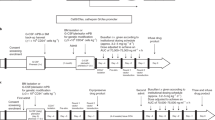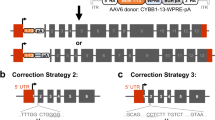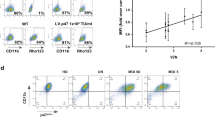Abstract
X-linked chronic granulomatous disease (X-CGD) is a primary immunodeficiency caused by mutations in the phagocyte nicotinamide dinucleotide phosphate oxidase catalytic subunit gp91phox. Gene therapy targeting hematopoietic stem cells (HSCs) can correct CGD, but permanent correction remains a challenge. Lentiviral vectors have become attractive tools for gene transfer, and they may have the potential to transduce very primitive HSCs. We used a self-inactivating RD114/TR-pseudotyped simian immunodeficiency virus (SIVmac)-based vector encoding human gp91phox for ex vivo transduction of peripheral blood-mobilized stem cells (PBSCs) from patients with X-CGD. In PBSCs from two patients, ex vivo transduction efficiencies of 40.5 and 46% were achieved, and correction of oxidase activity was observed in myeloid cells differentiating in culture. When transduced PBSCs from these patients were transplanted into nonobese diabetic/severe combined immunodeficient mice and compared to normal control, 10.5 and 7.3% of the human myeloid cells in bone marrow developing at 6 weeks from the human xenografts expressed the gp91phox transgene. Sustained functional correction of oxidase activity was documented in myeloid cells differentiated from engrafted transduced PBSCs. Transgene marking was polyclonal as assessed by vector integration site analysis. These data suggest that RD114/TR SIVmac-based vectors might be suitable for gene therapy of CGD and other hereditary hematologic diseases.
This is a preview of subscription content, access via your institution
Access options
Subscribe to this journal
Receive 12 print issues and online access
$259.00 per year
only $21.58 per issue
Buy this article
- Purchase on Springer Link
- Instant access to full article PDF
Prices may be subject to local taxes which are calculated during checkout






Similar content being viewed by others
References
Heyworth PG, Cross AR, Curnutte JT . Chronic granulomatous disease. Curr Opin Immunol 2003; 15: 578–584.
Winkelstein JA, Marino MC, Johnston Jr RB, Boyle J, Curnette J, Gallin JI et al. Chronic granulomatous disease. Report on a national registry of 368 patients. Medicine (Baltimore) 2000; 79: 155–169.
Hobbs JR, Monteil M, McCluskey DR, Jurges E, el Tumi M . Chronic granulomatous disease 100% corrected by displacement bone marrow transplantation from a volunteer unrelated donor. Eur J Pediatr 1992; 151: 806–810.
Horwitz ME, Barrett AJ, Brown MR, Carter CS, Childs R, Gallin JI et al. Treatment of chronic granulomatous disease with nonmyeloablative conditioning and a T-cell-depleted hematopoietic allograft. N Engl J Med 2001; 344: 881–888.
Li F, Linton GF, Sekhsaria S, Whiting-Theobald N, Katkin JP, Gallin JI et al. CD34+ peripheral blood progenitors as a target for genetic correction of the two flavocytochrome b558 defective forms of chronic granulomatous disease. Blood 1994; 84: 53–58.
Mardiney III M, Jackson SH, Spratt SK, Li F, Holland SM, Malech HL . Enhanced host defense after gene transfer in the murine p47phox-deficient model of chronic granulomatous disease. Blood 1997; 89: 2268–2275.
Ding C, Kume A, Björgvinsdottir H, Hawley RG, Pech N, Dinauer MC . High-level reconstitution of respiratory burst activity in a human X-linked chronic granulomatous disease (X-CGD) cell line and correction of murine X-CGD bone marrow cells by retroviral-mediated gene transfer of human gp91phox. Blood 1996; 88: 1834–1840.
Malech HL . Use of serum-free medium with fibronectin fragment enhanced transduction in a system of gas permeable plastic containers to achieve high levels of retrovirus transduction at clinical scale. Stem Cells 2000; 18: 155–156.
Malech HL, Choi U, Brenner S . Progress toward effective gene therapy for chronic granulomatous disease. Jpn J Infect Dis 2004; 57: S27–S28.
Malech HL, Maples PB, Whiting-Theobald N, Linton GF, Sekhsaria S, Vowells SJ et al. Prolonged production of NADPH oxidase-corrected granulocytes after gene therapy of chronic granulomatous disease. Proc Natl Acad Sci USA 1997; 94: 12133–12138.
Ott MG, Schmidt M, Schwarzwaelder K, Stein S, Siler U, Koehl U et al. Correction of X-linked chronic granulomatous disease by gene therapy, augmented by insertional activation of MDS1-EVI1, PRDM16 or SETBP1. Nat Med 2006; 12: 401–409.
Hacein-Bey-Abina S, von Kalle C, Schmidt M, Le Deist F, Wulffraat N, McIntyre E et al. A serious adverse event after successful gene therapy for X-linked severe combined immunodeficiency. N Engl J Med 2003; 348: 255–256.
Nienhuis AW, Dunbar CE, Sorrentino BP . Genotoxicity of retroviral integration in hematopoietic cells. Mol Ther 2006; 13: 1031–1049.
Naldini L, Blomer U, Gallay P, Ory D, Mulligan R, Gage FH et al. In vivo gene delivery and stable transduction of nondividing cells by a lentiviral vector. Science 1996; 272: 263–267.
Jetmore A, Plett PA, Tong X, Wolber FM, Breese R, Abonour R et al. Homing efficiency, cell cycle kinetics, and survival of quiescent and cycling human CD34+ cells transplanted into conditioned NOD/SCID recipients. Blood 2002; 99: 1585–1593.
Trono D . Lentiviral vectors: turning a deadly foe into a therapeutic agent. Gene Therapy 2000; 7: 20–23.
Wu X, Li Y, Crise B, Burgess SM . Transcription start regions in the human genome are favored targets for MLV integration. Science 2003; 300: 1749–1751.
Gilbert JR, Wong-Staal F . HIV-2 and SIV vector systems. Somat Cell Mol Genet 2001; 26: 83–98.
Dupuy FP, Mouly E, Mesel-Lemoine M, Morel C, Abriol J, Cherai M et al. Lentiviral transduction of human hematopoietic cells by HIV-1- and SIV-based vectors containing a bicistronic cassette driven by various internal promoters. J Gene Med 2005; 7: 1158–1171.
Kikuchi J, Mimuro J, Ogata K, Tabata T, Ueda Y, Ishiwata A et al. Sustained transgene expression by human cord blood derived CD34+ cells transduced with simian immunodeficiency virus agmTYO1-based vectors carrying the human coagulation factor VIII gene in NOD/SCID mice. J Gene Med 2004; 6: 1049–1060.
Sandrin V, Boson B, Salmon P, Gay W, Negre D, Le Grand R et al. Lentiviral vectors pseudotyped with a modified RD114 envelope glycoprotein show increased stability in sera and augmented transduction of primary lymphocytes and CD34+ cells derived from human and nonhuman primates. Blood 2002; 100: 823–832.
Cronin J, Zhang XY, Reiser J . Altering the tropism of lentiviral vectors through pseudotyping. Curr Gene Ther 2005; 5: 387–398.
Strang BL, Ikeda Y, Cosset FL, Collins MK, Takeuchi Y . Characterization of HIV-1 vectors with gammaretrovirus envelope glycoproteins produced from stable packaging cells. Gene Therapy 2004; 11: 591–598.
Hanawa H, Hematti P, Keyvanfar K, Metzger ME, Krouse A, Donahue RE et al. Efficient gene transfer into rhesus repopulating hematopoietic stem cells using a simian immunodeficiency virus-based lentiviral vector system. Blood 2004; 103: 4062–4069.
Haas DL, Case SS, Crooks GM, Kohn DB . Critical factors influencing stable transduction of human CD34+ cells with HIV-1-derived lentiviral vectors. Mol Ther 2000; 2: 71–80.
Roesler J, Brenner S, Bukovsky AA, Whiting-Theobald N, Dull T, Kelly M et al. Third-generation, self-inactivating gp91phox lentivector corrects the oxidase defect in NOD/SCID mouse-repopulating peripheral blood-mobilized CD34+ cells from patients with X-linked chronic granulomatous disease. Blood 2002; 100: 4381–4390.
Woods NB, Muessig A, Schmidt M, Flygare J, Olsson K, Salmon P et al. Lentiviral vector transduction of NOD/SCID repopulating cells results in multiple vector integrations per transduced cell: risk of insertional mutagenesis. Blood 2003; 101: 1284–1289.
Siapati EK, Bigger BW, Miskin J, Chipchase D, Parsley KL, Mitrophanous K et al. Comparison of HIV- and EIAV-based vectors on their efficiency in transducing murine and human hematopoietic repopulating cells. Mol Ther 2005; 12: 537–546.
Hematti P, Hong BK, Ferguson C, Adler R, Hanawa H, Sellers S et al. Distinct genomic integration of MLV and SIV vectors in primate hematopoietic stem and progenitor cells. PloS Biol 2004; 2: e423.
Negre D, Cosset FL . Vectors derived from simian immunodeficiency virus (SIV). Biochimie 2002; 84: 1161–1171.
Song B, Javanbakht H, Perron M, Park DH, Stremlau M, Sodroski J . Retrovirus restriction by TRIM5alpha variants from Old World and New World primates. J Virol 2005; 79: 3930–3937.
Gatlin J, Melkus MW, Padgett A, Kelly PF, Garcia JV . Engraftment of NOD/SCID mice with human CD34+ cells transduced by concentrated oncoretroviral vector particles pseudotyped with the feline endogenous retrovirus (RD114) envelope protein. J Virol 2001; 75: 9995–9999.
Relander T, Johansson M, Olsson K, Ikeda Y, Takeuchi Y, Collins M et al. Gene transfer to repopulating human CD34+ cells using amphotropic-, GALV-, or RD114-pseudotyped HIV-1-based vectors from stable producer cells. Mol Ther 2005; 11: 452–459.
Brenner S, Whiting-Theobald NL, Linton GF, Holmes KL, Anderson-Cohen M, Kelly PF et al. Concentrated RD114-pseudotyped MFGS-gp91phox vector achieves high levels of functional correction of the chronic granulomatous disease oxidase defect in NOD/SCID/beta-microglobulin−/− repopulating mobilized human peripheral blood CD34+ cells. Blood 2003; 102: 2789–2797.
Uchida N, Sutton RE, Friera AM, He D, Reitsma MJ, Chang WC et al. HIV, but not murine leukemia virus, vectors mediate high efficiency gene transfer into freshly isolated G0/G1 human hematopoietic stem cells. Proc Natl Acad Sci USA 1998; 95: 11939–11944.
Sutton RE, Reitsma MJ, Uchida N, Brown PO . Transduction of human progenitor hematopoietic stem cells by human immunodeficiency virus type 1-based vectors is cell cycle dependent. J Virol 1999; 73: 3649–3660.
Saulnier SO, Steinhoff D, Dinauer MC, Zufferey R, Trono D, Seger RA et al. Lentivirus-mediated gene transfer of gp91phox corrects chronic granulomatous disease (CGD) phenotype in human X-CGD cells. J Gene Med 2000; 2: 317–325.
Kume A, Dinauer MC . Retrovirus-mediated reconstitution of respiratory burst activity in X-linked chronic granulomatous disease cells. Blood 1994; 84: 3311–3316.
Goebel WS, Dinauer MC . Gene therapy for chronic granulomatous disease. Acta Haematol 2003; 110: 86–92.
Björgvinsdottir H, Ding C, Pech N, Gifford MA, Li LL, Dinauer MC . Retroviral-mediated gene transfer of gp91phox into bone marrow cells rescues defect in host defense against Aspergillus fumigatus in murine X-linked chronic granulomatous disease. Blood 1997; 89: 41–48.
Ramezani A, Hawley TS, Hawley RG . Lentiviral vectors for enhanced gene expression in human hematopoietic cells. Mol Ther 2000; 2: 458–469.
Hawley RG . Progress toward vector design for hematopoietic stem cell gene therapy. Curr Gene Ther 2001; 1: 1–17.
Crise B, Li Y, Yuan C, Morcock DR, Whitby D, Munroe DJ et al. Simian immunodeficiency virus integration preference is similar to that of human immunodeficiency virus type 1. J Virol 2005; 79: 12199–12204.
Montini E, Cesana D, Schmidt M, Sanvito F, Ponzoni M, Bartholomae C et al. Hematopoietic stem cell gene transfer in a tumor-prone mouse model uncovers low genotoxicity of lentiviral vector integration. Nat Biotechnol 2006; 24: 687–696.
Dunbar CE . Stem cell gene transfer: insights into integration and hematopoiesis from primate genetic marking studies. Ann NY Acad Sci 2005; 1044: 178–182.
de Mendez I, Adams AG, Sokolic RA, Malech HL, Leto TL . Multiple SH3 domain interactions regulate NADPH oxidase assembly in whole cells. EMBO J 1996; 15: 1211–1220.
McKenzie JL, Gan OI, Doedens M, Dick JE . Human short-term repopulating stem cells are efficiently detected following intrafemoral transplantation into NOD/SCID recipients depleted of CD122+ cells. Blood 2005; 106: 1259–1261.
Yamauchi A, Yu L, Potgens AJ, Kuribayashi F, Nunoi H, Kanegasaki S et al. Location of the epitope for 7D5, a monoclonal antibody raised against human flavocytochrome b558, to the extracellular peptide portion of primate gp91phox. Microbiol Immunol 2001; 45: 249–257.
Weil WM, Linton GF, Whiting-Theobald N, Vowells SJ, Rafferty SP, Li F et al. Genetic correction of p67phox deficient chronic granulomatous disease using peripheral blood progenitor cells as a target for retrovirus mediated gene transfer. Blood 1997; 89: 1754–1761.
Roesler J, Hecht M, Freihorst J, Lohmann-Matthes ML, Emmendorffer A . Diagnosis of chronic granulomatous disease and of its mode of inheritance by dihydrorhodamine 123 and flow microcytofluorometry. Eur J Pediatr 1991; 150: 161–165.
Acknowledgements
We are grateful to the laboratory of Arthur W Nienhuis (Experimental Hematology Division, Department of Hematology/Oncology, St Jude Children's Research Hospital, Memphis, TN, USA) for providing the parental SIVmac vector system. We thank Larry Lantz (Research Technologies Branch, National Institute of Allergy and Infectious Diseases, National Institutes of Health, Bethesda, MD, USA) for purification of the TM-β1 antibody. This research was supported by the Intramural Research Program of the National Institutes of Health, National Institute of Allergy and Infectious Diseases.
Author information
Authors and Affiliations
Corresponding author
Additional information
Supplementary Information accompanies the paper on Gene Therapy website (http://www.nature.com/gt).
Supplementary information
Rights and permissions
About this article
Cite this article
Naumann, N., De Ravin, S., Choi, U. et al. Simian immunodeficiency virus lentivector corrects human X-linked chronic granulomatous disease in the NOD/SCID mouse xenograft. Gene Ther 14, 1513–1524 (2007). https://doi.org/10.1038/sj.gt.3303010
Received:
Revised:
Accepted:
Published:
Issue Date:
DOI: https://doi.org/10.1038/sj.gt.3303010
Keywords
This article is cited by
-
Gene transfer into hematopoietic stem cells as treatment for primary immunodeficiency diseases
International Journal of Hematology (2014)
-
miRNA-mediated tumor specific delivery of TRAIL reduced glioma growth
Journal of Neuro-Oncology (2013)
-
A retroviral vector suitable for ultrasound image-guided gene delivery to mouse brain
Gene Therapy (2012)
-
Gene Therapy of Chronic Granulomatous Disease: The Engraftment Dilemma
Molecular Therapy (2011)
-
Optimal conditions for lentiviral transduction of engrafting human CD34+ cells
Gene Therapy (2011)



